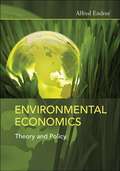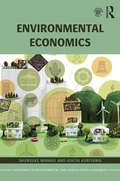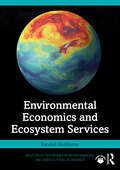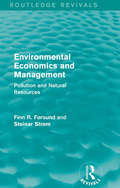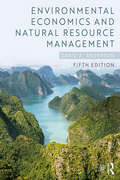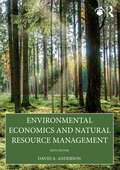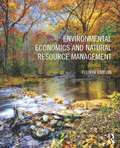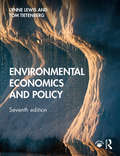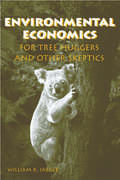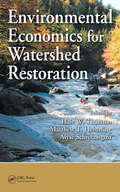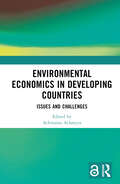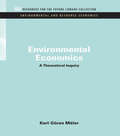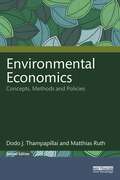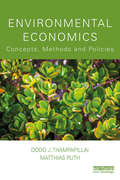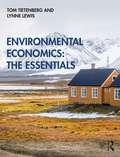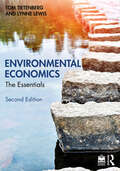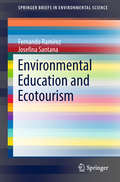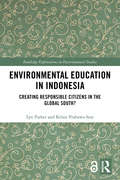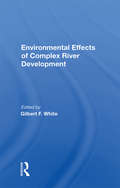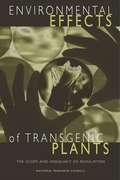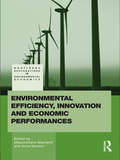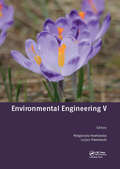- Table View
- List View
Environmental Economics
by Iain L. Fraser Alfred EndresThis intermediate-level undergraduate textbook in environmental economics builds on the microeconomics courses students take in their first year. It intentionally does not survey the whole field or present every possible topic. Instead, there is a clear focus on the theory of environmental policy and its practical applications. Most of the applied parts of the book deal with the economics of environmental policy in the European Union and in the United States. The book combines basic environmental economic analysis, such as the internalization of externalities, with recent developments in this field, including induced technical change and coalition theory. Moreover, topics from daily policy debates such as global warming are put into economic perspective. This is done in an intelligible form for advanced undergraduate students of economics, business administration and related fields. Each part of the book contains a set of exercises and suggested solutions.
Environmental Economics
by Iain L. Fraser Alfred EndresThis intermediate-level undergraduate textbook in environmental economics builds on the microeconomics courses students take in their first year. It intentionally does not survey the whole field or present every possible topic. Instead, there is a clear focus on the theory of environmental policy and its practical applications. Most of the applied parts of the book deal with the economics of environmental policy in the European Union and in the United States. The book combines basic environmental economic analysis, such as the internalization of externalities, with recent developments in this field, including induced technical change and coalition theory. Moreover, topics from daily policy debates such as global warming are put into economic perspective. This is done in an intelligible form for advanced undergraduate students of economics, business administration, and related fields. Each part of the book contains a set of exercises and suggested solutions.
Environmental Economics (Routledge Textbooks in Environmental and Agricultural Economics)
by Shunsuke Managi Koichi KuriyamaThis book aids those concerned about environmental issues to firmly grasp relevant analytical methods and to comprehend the thought process behind environmental economics. It does so by drawing from specific environmental issues and at the same time providing commentary that facilitates understanding. This text contains in-depth explanations necessary for a thorough understanding of the fundamental aspects and importance of environmental economics. Environmental Economics seeks to elucidate the mechanisms that give rise to environmental problems by approaching environmental issues from an economic perspective. At the same time, it is a study aiming to indicate specific countermeasures that could resolve present environmental issues. This text has been put together in way that allows readers without specialized economics knowledge to easily understand the situation, issues and challenges of environmental economics.
Environmental Economics and Ecosystem Services (Routledge Textbooks in Environmental and Agricultural Economics)
by Randall BluffstoneEnvironmental Economics and Ecosystem Services provides a rigorous yet accessible introduction to environmental economics, using ecosystem services as the underlying framework. Assuming no prior knowledge of economics, and using a conversational writing style, the focus is on exploring society’s linkages with the environment and how economics can help solve key environmental problems.Structured in three parts, the book first introduces readers to the key theories in environmental economics and ecosystem services, and then explores the challenges of conservation. The final section examines environmental policy options, such as cap-and-trade, behavioral nudges, community-based natural resource management and carbon taxes. There is a strong international focus throughout the book, with real-life examples taken from North America, Europe, Asia, Africa and other regions. Students are supported by a range of pedagogical features, including chapter objectives, chapter summaries, discussion questions and further reading suggestions. In addition, the book offers worked examples, analytical problems and “Challenge Yourself” boxes to develop critical thinking skills. Lecture slides and answers to questions for discussion and practice problems are available for instructors.This is the ideal text for introductory courses in environmental economics, ecological economics, economics of sustainability, environmental management, environmental policy and ecosystem services.
Environmental Economics and Management: Pollution and Natural Resources (Routledge Revivals)
by Steinar Strøm Finn R FørsundFirst published in 1988, this book examines pollution and natural resources in relation to economic analysis. The section on pollution looks at areas such as the main problems in the field at the time, possible remedies and the environmental costs involved. In regards to natural resources, the book considers both the exploitation of non-renewable resources and commercial fishing. The non-technical introduction to the main problems set out in each chapter will appeal to the general reader whilst the formal models and more technical parts make the material equally suitable for more advanced students or those with specialist knowledge.
Environmental Economics and Natural Resource Management
by David A. AndersonThe tools of environmental economics guide policymakers as they weigh development against nature, present against future, and certain benefits against uncertain consequences. The policies and research findings explained in this textbook are relevant to decisions made daily by individuals, firms, and governments. This textbook offers instructors and students a user-friendly, relevant, and up-to-date introduction to these topics while covering recent advancements in the field and significant political and economic changes. The fifth edition has been thoroughly updated while retaining the story-based narratives and visual emphasis of previous editions, capturing students’ attention with full-color photos, graphs, and illustrations. It addresses the impact of changes in world leaders, national priorities, and international agreements along with key developments in the energy sector. These include the way hydraulic fracturing and the surging popularity of natural gas have revolutionized the fossil fuel industries; how new, green-energy technologies are bringing prices down and efficiency levels up; and the arrival of innovative energy sources such as ocean-thermal energy conversion. Environmental Economics and Natural Resource Management promotes environmental and economic literacy with policy-oriented, application-based content, all delivered in concise, accessible discussions. Through its engaging approach, the text brings the economic way of thinking into discussions of personal, community, corporate, and government activities that affect environmental assets and the quality of life.
Environmental Economics and Natural Resource Management
by David A. AndersonThe tools of environmental economics guide policymakers as they weigh development against nature, present against future, and certain benefits against uncertain consequences. The policies and research findings explained in this textbook are relevant to decisions made daily by individuals, firms, and governments. This textbook offers instructors and students a user-friendly, relevant, and up-to-date introduction to these topics while covering recent advancements in the field and significant political and economic changes.The book has been thoroughly updated while retaining the story-based narratives and visual emphasis of previous editions, capturing students’ attention with full-color photos, graphs, and illustrations. This sixth edition includes: Updated coverage of international environmental regulations, the effects of the COVID-19 pandemic on the environment, the effects of war on the environment, recent environmental summits and agreements, the evolving energy and transportation sectors, and trailblazing policies and research Expanded coverage of environmental issues and approaches in underrepresented countries and continents New discussions of EV batteries, populist leaders, carbon leakage, food waste, and ecological resilience Revised digital supplements, including a solutions guide, PowerPoints, and sample tests. Environmental Economics and Natural Resource Management promotes environmental and economic literacy with policy-oriented, application-based content delivered in concise, accessible discussions. Through its engaging approach, the text brings the economic way of thinking into discussions of personal, community, corporate, and government activities that affect environmental assets and the quality of life.
Environmental Economics and Natural Resource Management: And Natural Resource Management
by David A. AndersonThe tools of environmental economics guide policymakers as they weigh development against nature, present against future, and certain benefits against uncertain consequences. From reluctant-but-necessary calculations of the value of life, to quandaries over profits at the environment's expense, the policies and research findings explained in this textbook are relevant to decisions made daily by individuals, firms, and governments. The fourth edition of Environmental Economics and Natural Resource Management pairs the user-friendly approaches of the previous editions with the latest developments in the field. A story-based narrative delivers clear, concise coverage of contemporary policy initiatives. To promote environmental and economic literacy, we have added even more visual aids, including color photographs and diagrams unmatched in other texts. Ancillaries include an Instructor's Guide with answers to all of the practice problems and downloadable slides of figures and tables from the book. The economy is a subset of the environment, from which resources are obtained, workers and consumers receive sustenance, and life begins. Energy prices and environmental calamities constrain economic growth and the quality of life. The same can be said about overly restrictive environmental policies. It is with an appreciation for the weighty influence of this discipline, and the importance of conveying it to students, that this textbook is crafted.
Environmental Economics and Policy
by Lynne Lewis Thomas H. TietenbergEnvironmental Economics and Policy is a best-selling text for environmental economics courses. Offering a policy-oriented approach, it introduces economic theory, empirical fieldwork, and case studies that show how underlying economic principles provided the foundation for environmental policies. Key features include: Introductions to the theory and method of environmental economics, including externalities, benefit-cost analysis, valuation methods, and ecosystem goods and services. Extensive coverage of the major issues including climate change mitigation and adaptation, air and water pollution, and environmental justice. Boxed "Examples" and "Debates" throughout the text, which highlight global examples and major talking points. This text will be of use to undergraduate students of economics. Students will leave the course with a global perspective of how environmental economics has played and can continue to play a role in promoting fair and efficient environmental management. The text is fully supported with end-of-chapter summaries, discussion questions, and self-test exercises in the book. Additional online resources include references, as well as PowerPoint slides for each chapter.
Environmental Economics for Tree Huggers and Other Skeptics
by William K. JaegerThough many students and environmentalists shudder at even the thought of economics, a working knowledge of the basics can be a powerful ally. Economic arguments carry a great deal of weight, and putting them to work for environmental causes can be a deciding factor, especially in policy debates. The reverse is true as well, and an understanding of the possibly flawed, misleading, or overstated economics behind an opponent's case can be crucially important. Environmental Economics for Tree Huggers and Other Skeptics carefully explains the tools of economic analysis and shows how they can be used to help reveal the root causes of and potential solutions for environmental and natural resource problems. Jaeger's proven techniques and wonderfully conversational tone assume no economics training, and his presentation of the material is designed to facilitate clarity. His step-by-step approach unearths surprisingly simple, easy-to-remember principles and shows how to apply them to real-world environmental problems. Those with exposure to introductory microeconomics will find Environmental Economics for Tree Huggers and Other Skeptics to be a welcome refresher. Undergraduate and graduate students of environmental studies, resource management, law, policy, and related fields, as well as novices who are skeptical of how the field could possibly help them in their own efforts, will be pleasantly surprised.
Environmental Economics for Watershed Restoration
by Matthew T. Heberling Hale W. Thurston Alyse SchrecongostWhether addressing pollution problems or helping protect a specific use, watershed associations are finding that the competition for funds is getting harder. While we can grasp the value of our streams for fishing or kayaking and other services, or their cultural value, or their value to an ecosystem, putting a dollar value on those benefits is not
Environmental Economics in Developing Countries: Issues and Challenges
by Achiransu AcharyyaThe COVID-19 pandemic has laid bare the vulnerabilities of socio-economic systems globally and exposed the risks that natural capital degradation imposes on human health, economy, and society. This book studies the environmental challenges faced by developing economies in a post-COVID-19 world. Exploring diverse case studies from South Asia and Sub-Saharan Africa, the volume discusses the impact that economic development and, recently, COVID-19 has had on the environment, ecology, and economy of these regions. It analyses nature conservation policies aimed at minimizing ecological damage arising from economic development and discusses the policy objectives of sustainable development. It also highlights the significant role that environmental economics networks have played in capacity building, framing of policies using ecological economics tools, and developing a local leadership trained in addressing local sustainability issues. An important contribution to the study of environmental economics of the Global South, the book will be of interest to students and researchers of economics, environment, development studies, development economics, environmental policies, and South Asia studies. It will also be useful for policymakers and NGOs working in this field.
Environmental Economics: A Theoretical Inquiry (RFF Environmental and Resource Economics Set)
by Karl-Goran MalerFirst Published in 2011. Routledge is an imprint of Taylor & Francis, an informa company.
Environmental Economics: Concepts, Methods and Policies
by Matthias Ruth Dodo J. ThampapillaiEnvironmental Economics explores the ways in which economic theory and its applications, as practised and taught today, must be modified to explicitly accommodate the goal of sustainability and the vital role played by environmental capital.Pivoting around the first and second laws of thermodynamics, as well as the principles of ecological resilience, this book is divided into five key parts, which include extensive coverage of environmental microeconomics and macroeconomics. It drills down into issues and challenges including consumer demand; production and supply; market organisation; renewable and non-renewable resources; environmental valuation; macroeconomic stabilisation and international trade and globalisation. Drawing on case studies from forestry, water, soil, air quality and mining, this book will equip readers with skills that enable the analyses of environmental and economic policy issues with a specific focus on the sustainability of the economy. This new edition has been updated throughout and provides further coverage on topics such as energy transition, market organisation and the role of environmental economics in regulatory decision-making including critiques of contemporary policy directives like tradable pollution permits and net zero emissions. Challenges to achieving stabilisation and emission reduction have been expanded to include wars and conflicts such as those in the Middle East and the Russian invasion of Ukraine. This book further reinforces the premise that there are clear limits to growth and that modesty and moderation are superior alternatives.Rich in pedagogical features, including key concept boxes and review questions at the end of each chapter, this book will be a vital resource for upper-level undergraduate and postgraduate students studying not only environmental economics/ecological economics but also economics in general.
Environmental Economics: Concepts, Methods and Policies (New Horizons In Environmental Economics Ser.)
by Matthias Ruth Dodo J. ThampapillaiEnvironmental Economics explores the ways in which economic theory and its applications, as practised and taught today, must be modified to explicitly accommodate the goal of sustainability and the vital role played by environmental capital. Pivoting around the first and second laws of thermodynamics, as well as the principles of ecological resilience, this book is divided into five key parts, which includes extensive coverage of environmental microeconomics and macroeconomics. It drills down into issues and challenges including consumer demand; production and supply; market organisation; renewable and non-renewable resources; environmental valuation; macroeconomic stabilisation, and international trade and globalisation. Drawing on case studies from forestry, water, soil, air quality, and mining, this book will equip readers with skills that enable the analyses of environmental and economic policy issues with a specific focus on the sustainability of the economy. Rich in pedagogical features, including key concepts boxes and review questions at the end of each chapter, this book will be a vital resource for upperlevel undergraduate and postgraduate students studying not only environmental economics/ecological economics but also economics in general.
Environmental Economics: The Essentials
by Tom Tietenberg Lynne LewisEnvironmental Economics: The Essentials offers a policy-oriented approach to the increasingly influential field of environmental economics that is based upon a solid foundation of economic theory and empirical research. Students will not only leave the course with a firm understanding of environmental economics, but they will also be exposed to a number of case studies showing how underlying economic principles provided the foundation for specific environmental and resource policies. This key text highlights what insights can be derived from the actual experience. Key features include: Extensive coverage of the major issues including climate change, air and water pollution, sustainable development, and environmental justice; Introductions to the theory and method of environmental economics including externalities, experimental and behavioral economics, benefit-cost analysis, and methods for valuing the services provided by the environment; Boxed ‘Examples’ and ‘Debates’ throughout the text which highlight global examples and major talking points. The text is fully supported with end-of-chapter summaries, discussion questions, and self-test exercises in the book, as well as with multiple-choice questions, simulations, references, slides, and an instructor’s manual on the Companion Website. This text is adapted from the best-selling Environmental and Natural Resource Economics, 11th edition, by the same authors.
Environmental Economics: The Essentials
by Tom Tietenberg Lynne LewisEnvironmental Economics: The Essentials offers a policy-oriented approach to the increasingly influential field of environmental economics that is based on a solid foundation of economic theory and empirical research. Students will not only leave the course with a firm understanding of environmental economics, but they will also be exposed to a number of case studies showing how underlying economic principles provided the foundation for specific environmental and resource policies. This key text highlights what insights can be derived from the actual experience.Key features include: Extensive coverage of the major issues, including climate change, air and water pollution, sustainable development, and environmental justice Introductions to the theory and method of environmental economics, including externalities, experimental and behavioral economics, benefit-cost analysis, and methods for valuing the services provided by the environment Boxed Examples and Debates throughout the text, which highlight global cases and major talking points This second edition provides updated data, new studies, and more international examples. There is a considerable amount of new material, with a deeper focus on climate change. The text is fully supported with end-of-chapter summaries, discussion questions, and self-test exercises in the book, as well as a suite of supplementary digital resources, including multiple-choice questions, simulations, references, slides, and an instructor’s manual. It is adapted from the 12th edition of the best-selling Environmental and Natural Resource Economics textbook by the same authors.
Environmental Education and Ecotourism (SpringerBriefs in Environmental Science)
by Fernando Ramírez Josefina SantanaThis SpringerBrief focuses on the principles of ecotourism such as relevance of the field, origin, fundamental aspects, definitions, philosophy, implications in biodiversity conservation and environmental impacts. Special emphasis is also given to the interaction between ecotourism and education and it is supported by recent publications from the authors.
Environmental Education in Indonesia: Creating Responsible Citizens in the Global South? (Routledge Explorations in Environmental Studies)
by Lyn Parker Kelsie Prabawa-SearIndonesia’s wealth of natural resources is being exploited at breakneck speed, and environmental awareness and knowledge among the populace is limited. This book examines how young people learn about the environment to see how education can help to develop environmental awareness and avert vast environmental destruction, not only in Indonesia, but also in the Global South more generally. Based on in-depth studies conducted in the cities of Yogyakarta and Surabaya, complemented with surveys of students in secondary schools, Environmental Education in Indonesia examines educational curricula, pedagogy and "green" activities to reveal what is currently being done in schools to educate children about the environment. The book investigates the shortcomings in environment education, including underqualified teachers, the civil service mentality, the still-pervasive chalk-and-talk pedagogy and the effect of the examination system. It also analyses the role of local government in supporting (or not) environmental education, and the contribution of environmental NGOs. The book establishes that young people are not currently being exposed to effective environmental education, and the authors propose that the best and most culturally appropriate way forward in Indonesia is to frame pro-environment behaviour and responsibility as a form of citizenship, and specifically that environmental education should be taught as a separate subject. This book will be of great interest to students and scholars of contemporary Indonesia and Southeast Asia, education for sustainability and environmental education, as well as sustainability and sustainable development more generally.
Environmental Effect/h: International Experience
by Gilbert F. WhiteIn our critical attempts to solve the pressing current problems of a limited water supply, it is essential that we act always with a global view to the future. Recognizing this, an international group of scholars—from the Soviet Union, Canada, Africa, and the United States—met to review together their experiences and research on the environmental effects of a number of large scale river management programs. This edited collection of their reports provides a balanced view of a vital element in the total ecosystem. Their analysis points out the urgent need to take account of long-term trends in climate, to consider all feasible management alternatives, and, especially, to manage demand (as opposed to simply increasing water supply) and to defer irreversible action until all environmental impacts are estimated.
Environmental Effects of Transgenic Plants: The Scope and Adequacy of Regulation
by National Research CouncilTransgenic crops offer the promise of increased agricultural productivity and better quality foods. But they also raise the specter of harmful environmental effects. In this new book, a panel of experts examines: • Similarities and differences between crops developed by conventional and transgenic methods • Potential for commercialized transgenic crops to change both agricultural and nonagricultural landscapes • How well the U.S. government is regulating transgenic crops to avoid any negative effects. Environmental Effects of Transgenic Plants provides a wealth of information about transgenic processes, previous experience with the introduction of novel crops, principles of risk assessment and management, the science behind current regulatory schemes, issues in monitoring transgenic products already on the market, and more. The book discusses public involvement—and public confidence—in biotechnology regulation. And it looks to the future, exploring the potential of genetic engineering and the prospects for environmental effects.
Environmental Efficiency, Innovation and Economic Performances
by Massimiliano Mazzanti Anna MontiniThis book deals with the increasingly complex issues of eco-innovation. Eco-innovation is becoming a conceptual reference point for many regional and international public policies and management strategies. Since 2000, this field of research has been focusing on environmental innovation, particularly related to the intensity of emissions, and economic performance and efficiency. There are two reasons for this growing interest. The first is that environmental performance is one of the main economic policy goals of European countries thanks to its relevance to the Lisbon Strategy and the Göteborg priorities for sustainable development. The second, which is partly linked to the first, is related to the growing impact of environmental regulation on private sector activity in many European countries. This volume brings together microeconomics studies on firms’ eco and economic performance both in the industrial and service sector; by considering a sector based perspective rooted mainly in the exploitation of NAMEA data; at regional level, and a macroeconomic analysis of the environment, income and welfare. This collection brings together the best of recent research in the area of eco-innovation and in its entirety is an excellent source of knowledge for postgraduates and researchers students of Environmental and Ecological Economics alike. As well as fully developing the theoretical aspects of its topics, these essays are also strongly policy-oriented and will be of interest to anyone seeking information an applied perspective.
Environmental Engineer (Cool Cutting Edge Careers)
by Geoffrey M. HornHow can we keep our drinking water pure? Whats the best way to dispose of our waste? How can we limit pollution? Answering these questions is the job of environmental engineers. Using the latest technology and research, environmental engineers are changing our world. Learn about the many different jobs that make up this cutting-edge career.
Environmental Engineering III
by Lucjan Pawłowski Marzenna R. Dudzińska Artur PawłowskiEnvironmental engineering has a leading role in the elimination of ecological threats, and can deal with a wide range of technical and technological problems due to its interdisciplinary character. It uses the knowledge of the basic sciences � biology, chemistry, biochemistry and physics � to neutralize pollution in all the elements of the environm
Environmental Engineering V
by Lucjan Pawłowski Małgorzata PawłowskaPoland, like other post-communist countries, is undergoing a transformation into a capitalist system. This transformation affects the country in many ways: economic, social, psychological and also ecological. Ecological problems are strongly connected with the political, economic and psychological inheritance of the past, as well as with changes in the post-communist society. In order to understand these problems, it is necessary to consider the following issues:- the geographic situation of Poland - the political transformations that occurred after World War II – forced development of heavy industry combined with neglect of its effects on the environment, and - the economic problemsThe three main goals of Environmental Engineering V are (I) to assess the state of scientific research in various areas of environmental engineering. (II) to evaluate organizational, technical and technological progress in contributing to ecological security, and (III) to determine the place of environmental engineering in sustainable development, taking into account political and economic conditions. Environmental Engineering V is of interest for academics, engineers and professionals involved in environmental engineering, seeking solutions for environmental problems in emerging new democracies, especially those who plan to participate in numerous projects sponsored by the European Union.
